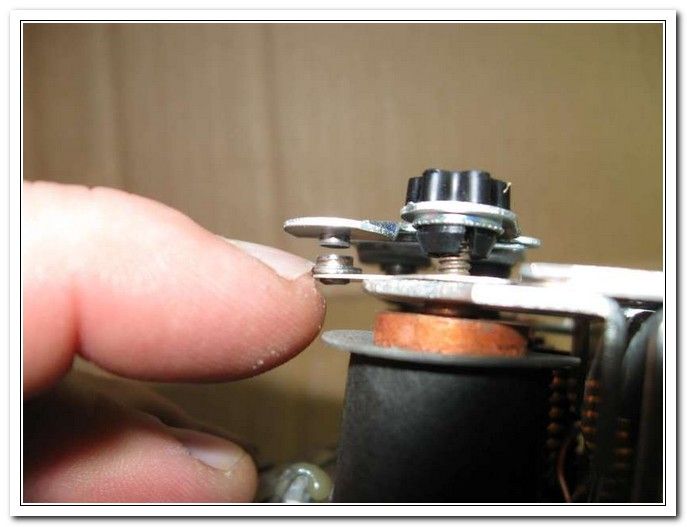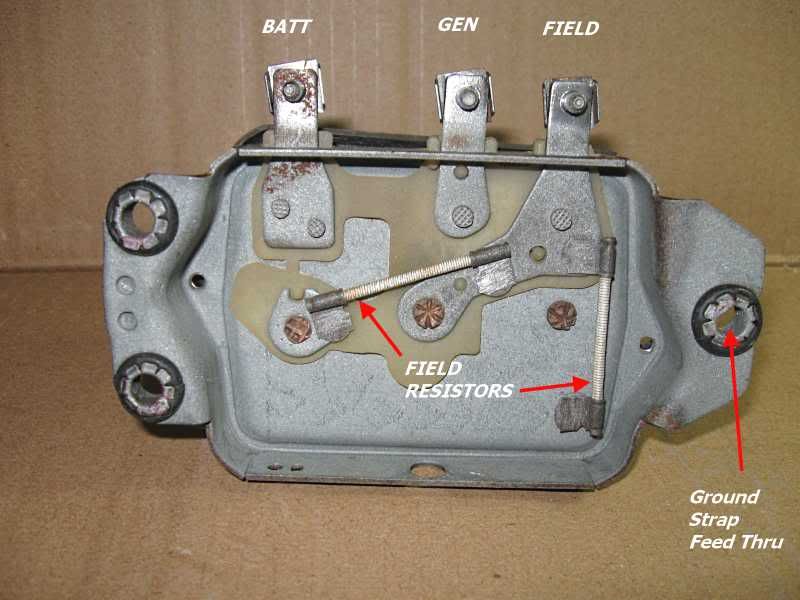
 |
PLEASE PATRONIZE OUR SPONSORS!






|
|||||||
 |
|
|
Thread Tools | Display Modes |
|
#1
|
||||
|
||||
|
I recently purchased a 126. Tractor is pretty straight, all the tires hold air, but was not running. I went throught the carb and had to completely rewire the thing. I got the wiring done the other night and she started right up, and is probably one of my best running cubs. My issue now is that as I was taking my first test drive, I noticed that the ammeter was pegged anytime the tractor was above an idle. I also noticed some battery acid leaking. The battery is a new one, and it did not feel hot at any time, and was not securely fastened, so it may just be leaking from bouncing around, but I was concerned that it was overcharging. I shut it down and sprayed it off, and when I restarted the tractor it seemed to be regulating more, but is still charging quite a bit, but I did not notice acid any more. One thing that I realize now is that I did not re-polarize the generator after I had all the wires off. Could that be an issue? Bad V/R? Just a fluke?
__________________
--- 5x Originals, one with rear PTO, 70, 2x 100's, one w/ creeper,2x 102's, 2x 122 w/creeper and rear pto, 2x 123's, 105, 125 w/ aux hyd,2x 73's, 126, 2x 147, 86, 2x 108's, 129, 2x 149's, 169, 3x 800's, 2x 1100's, 1250, 3x 1650's, 682, 2x 782's, 782D, 982 w/60" Haban, 1872 w/ Haban deck 2 Rear Tillers, 1 Snowblower, #1 cart and 2x #2 cart IH/Cub Cadet 79C Chipper 526 Front Tine Tiller Brinly plow, disk, grader blade |
|
#2
|
|||
|
|||
|
I would look in the area of the V/R. Make sure that the V/R is properly grounded. Check by measuring the resistance between the V/R case and the negative battery terminal. It should read zero ohms.
__________________
[B]Roland Bedell[/B] CC Models: 100, 105, 1450, 782, (2) 784, & 2072 [SIZE="4"][B][COLOR="Red"]Buy:[/COLOR][COLOR="Blue"] Made in the USA[/COLOR][/B] [/SIZE]:American Flag 1: |
|
#3
|
|||
|
|||
|
Can't rely on the amp gauge. I have a couple cubs that when first started the gauge pins and after a few minutes it comes down. The voltage is fine. You have to put it on a volt meter and amp meter to see if it just the gauge.
Keep us posted. |
|
#4
|
||||
|
||||
|
With the tractor idling, I have ~14.5 v, full thottle I have~18 volts. Zero resistance between neg terminal and reg ground, as well as the gen and f terminals of the reg, seem to have infinite resistance on the batt termianal of the reg.
__________________
--- 5x Originals, one with rear PTO, 70, 2x 100's, one w/ creeper,2x 102's, 2x 122 w/creeper and rear pto, 2x 123's, 105, 125 w/ aux hyd,2x 73's, 126, 2x 147, 86, 2x 108's, 129, 2x 149's, 169, 3x 800's, 2x 1100's, 1250, 3x 1650's, 682, 2x 782's, 782D, 982 w/60" Haban, 1872 w/ Haban deck 2 Rear Tillers, 1 Snowblower, #1 cart and 2x #2 cart IH/Cub Cadet 79C Chipper 526 Front Tine Tiller Brinly plow, disk, grader blade |
|
#5
|
||||
|
||||
|
There's something wrong with the regulator...you should never see more than 14.5V at any time with the engine running.
|
|
#6
|
||||
|
||||
|
Disconnect the (+) battery cable before (if) you try this. If you ignore this warning, the tractor could come to life if you mistakenly close the cutout relay contacts. The tractor could motor forward under the power of the SG motor and damage property or endanger you or bystanders.
Open the regulator case and check the contacts on both relays inside the case. When not running, the contacts of the CUTOUT relay should be OPEN. The contacts of the voltage / current relay will be NORMALLY CLOSED. The issue might be that they are welded closed and therefore cannot open the ground to the field coils in the SG motor. If the relay contacts fail to open and the field coil stays fully grounded, no voltage regulation OR OVER CURRENT PROTECTION for the SG motor is available. You may be able to gently pry the contacts open with nothing more than light fingernail pressure peeling the contacts apart. Don't overdo the pressure, they should separate easily. If they separate with a "snap", you will most likely see evidence of corrosion or pitting. A points file or very light grit wet/ dry paper (400 / 800 grit) may get the regulator back in operation. It may only be temporary, but it would allow you not to guess when it comes time to open your wallet and take out some hard earned cash !!  Chuck
__________________
If you do not learn something new every day ... you are not paying attention ! |
|
#7
|
||||
|
||||
|
Well I did some investigating on my regulator and the contacts associated with the F terminal was closed and had a lot of buildup on it. the contact for the Gen was open and clean. I cleaned up the F terminal with a point file and started it up with a meter on the battery. The contacts for the F terminal never seem to open. I can open them with a screwdriver, which then closes the gen contact and thus educes the output, but things go back as before when I release the F terminal. I did put another reg, which I thought to be bad as I had removed it from a tractor that was not charging which then charged with a different reg, but this"bad" regulator seems to regulate better on the 126. It will put out 13.5-14 at WOT, and 12.5-13 at idle speed. I guess I will just have to use it some and see if it stays charged. Can anything be bench tested or adjustrd/fixed on a faulty regulator or does it have to be replaced? Thanks for the help, I understand these things much better now.
__________________
--- 5x Originals, one with rear PTO, 70, 2x 100's, one w/ creeper,2x 102's, 2x 122 w/creeper and rear pto, 2x 123's, 105, 125 w/ aux hyd,2x 73's, 126, 2x 147, 86, 2x 108's, 129, 2x 149's, 169, 3x 800's, 2x 1100's, 1250, 3x 1650's, 682, 2x 782's, 782D, 982 w/60" Haban, 1872 w/ Haban deck 2 Rear Tillers, 1 Snowblower, #1 cart and 2x #2 cart IH/Cub Cadet 79C Chipper 526 Front Tine Tiller Brinly plow, disk, grader blade |
|
#8
|
||||
|
||||
|
The relay contact that you are opening manually should open by itself under one of two different conditions, either an OVER VOLTAGE or an OVER CURRENT condition.
The voltage / current relay has two independent coils in the relay winding. The first coil of magnetic wire is of very small diameter wire and several hundred wraps of this wire. This winding will pull the relay contacts apart when a certain VOLTAGE is present across this winding. So if the battery charge voltage goes over - say - 14 volts, the relay opens up at 14 volts and stops the SG motor from over charging to the battery. The second winding in this same relay is a much heavier gauge wire - like 14 gauge house wiring. This winding passes all the CURRENT from the SG motor to the tractor components (battery, ignition, etc). If the amount of current thru this winding produces enough magnetism to pull apart the same relay contacts, the SG motor is then protected against an OVER CURRENT condition and keeps the SG motor from burning out. So either over voltage or over current will trigger that same relay contact to open and shut down the SG motor charge. In real life, the SG motor does not shut off but goes to a "low output" condition. When the volt / current relay opens. a high wattage resistor is placed in series with the F terminal on the SG motor. This resistor causes the SG motor to output a lower voltage than when the relay contacts short the F terminal to ground. With this "idling resistor" in the circuit, the SG motor does electrically slam on and off - it goes between full on and half on. This saves stress on the SG motor and electrical components in the tractor. The "idling resistor" is placed on the underside of the regulator assy   FYI - the reg pictured above is a three relay setup - one for cutout, one for over voltage and one for over current. Cub regs only have two relays and combine the over current and over voltage relays into one relay.
__________________
If you do not learn something new every day ... you are not paying attention ! |
 |
|
|
Cub Cadet is a premium line of outdoor power equipment, established in 1961 as part of International Harvester. During the 1960s, IH initiated an entirely new line of lawn and garden equipment aimed at the owners rural homes with large yards and private gardens. There were a wide variety of Cub Cadet branded and after-market attachments available; including mowers, blades, snow blowers, front loaders, plows, carts, etc. Cub Cadet advertising at that time harped on their thorough testing by "boys - acknowledged by many as the world's worst destructive force!". Cub Cadets became known for their dependability and rugged construction.
MTD Products, Inc. of Cleveland, Ohio purchased the Cub Cadet brand from International Harvester in 1981. Cub Cadet was held as a wholly owned subsidiary for many years following this acquisition, which allowed them to operate independently. Recently, MTD has taken a more aggressive role and integrated Cub Cadet into its other lines of power equipment.
This website and forum are not affiliated with or sponsored by MTD Products Inc, which owns the CUB CADET trademarks. It is not an official MTD Products Inc, website, and MTD Products Inc, is not responsible for any of its content. The official MTD Products Inc, website can be found at: http://www.mtdproducts.com. The information and opinions expressed on this website are the responsibility of the website's owner and/or it's members, and do not represent the opinions of MTD Products Inc. IH, INTERNATIONAL HARVESTER are registered trademark of CNH America LLC
All material, images, and graphics from this site are the property of www.onlycubcadets.net. Any unauthorized use, reproductions, or duplications are prohibited unless solely expressed in writing.
Cub Cadet, Cub, Cadet, IH, MTD, Parts, Tractors, Tractor, International Harvester, Lawn, Garden, Lawn Mower, Kohler, garden tractor equipment, lawn garden tractors, antique garden tractors, garden tractor, PTO, parts, online, Original, 70, 71, 72, 73, 76, SO76, 80, 81, 86, 100, 102, 104, 105, 106, 107, 108,109, 122, 123, 124, 125, 126, 127, 128, 129, 147, 149, 169, 182, 282, 382, 482, 580, 582, 582 Special, 680, 682, 782, 782D, 784, 800, 805, 882, 982, 984, 986, 1000, 1015, 1100, 1105, 1110, 1200, 1250, 1282, 1450, 1512, 1604, 1605, 1606, 1610, 1615, 1620, 1650, 1710, 1711, 1712, 1806, 1810, 1811, 1812, 1912, 1914.